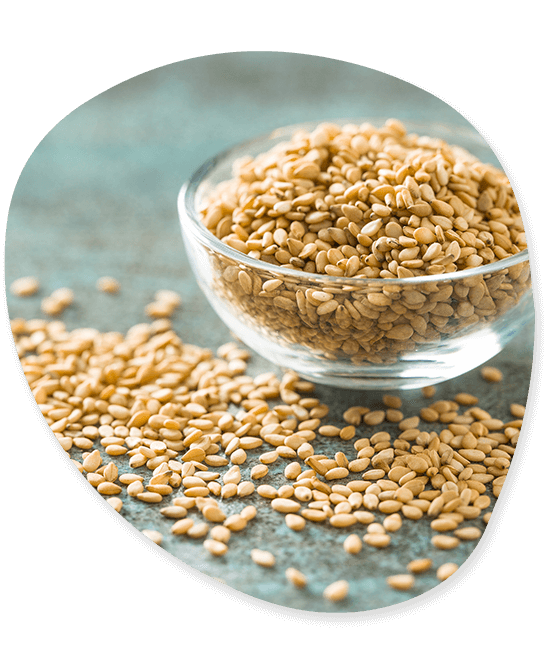Sesame
An annual herb that thrives in hot temperatures is sesame. Tonnes of sesame are exported by an Indian sesame exporter to numerous nations. Sesame is well known for its numerous health and cosmetic advantages. Sesame is becoming more and more well-liked around the world, and India has been exporting more sesame each year. This is a great chance for the Indian exporter of sesame to break into the global market. Numerous varieties of sesame are exported from India along with sesame.

Nutrients:
- Calories – 573 calories
- Dietary Fiber – 12 g
- Total Carbohydrate 23 g
Minerals:
Vitamins:
Protein:
Pre-Shipment Inspection:
Standard Packing:
- We provide packaging in terms of 5, 10, 20, 25, 50 and 100kg also, as per the customers’ (country) requirement.
SESAME VARIETIES WE EXPORT
Several types of sesame, including TKG-306, SWB-32-10-1, and other cultivars, are imported from India. High-quality sesame is exported from India to various countries across the world. The following types of sesame are exported from India.

TKG-306
TKG-306, which was made available in 2007, requires 86 to 90 days to mature. The seed is about 2.8 g in weight and is white in colour. This type of sesame is resistant to Phytophthora blight and only somewhat susceptible to Alternaria leaf spot, Macrophomina, Cercospora, and powdery mildew.

SWB-32-10-1 (SAVITRI)
Sesame seeds from the SWB-32-10-1 type have an oil content that ranges from 48 to 52%. In the summer, this cultivar typically yields 1200–1500 kg/ha. West Bengal has endorsed this kind. This cultivar takes between 84 and 88 days to reach maturity.

JAWAHAR TIL –12 (PKDS-12)
This type of sesame has an oil level that ranges from 48 to 52%. The Jawahar Til-12 cultivar has an average yield of 700–750 kg/ha. It has been suggested that this cultivar be grown in Madhya Pradesh throughout the summer. According to reports, this variety has a mediocre resistance to Macrophomina stem/root rot.

GUJARAT TIL-3
The Gujarat Til-3 has an average oil content of 48 to 52%. This cultivar of sesame produces an average yield of 750–800 kg/ha. In Gujarat’s Saurashtra region, growing this crop during the Kharif season has been advised. These seeds need between 84 and 88 days to develop.

RT-346
Around 49–51% of the RT-346 is made up of oil. This cultivar of sesame produces an average yield of 750–850 kg/ha. In the states of Rajasthan, Haryana, Panjab, Himachal Pradesh, Gujarat, Uttar Pradesh, Maharashtra, and others, it is advised to plant this type during the Kharif season. The cultivar needs between 82 and 86 days to mature.

JLT-408
Around 51–53% of JLT-408 is made up of oil. This cultivar of sesame produces an average yield of 700–800 kg/ha. It is advised to grow this kind of sesame in Vidharba, the Marathwada region, and other nearby areas of Khandesh where there is a guarantee of rainfall. It takes this type of sesame 80–85 days to mature.

TKG-308
TKG-308 contains between 48 and 50 percent oil. yield of 700–750 kg/ha on average. This type can tolerate capsule borer and is tolerably resistant to Macrophomia, Cercospora, Bacteria leaf spot, Leaf curl, and Leaf curl.

SHUBRA
Sesame seeds from the Shubhra variety have an oil level of 48–52%. This variety has an average yield of 800-900 kg/ha. The colour of the seeds is golden yellow. The Kharif and summer months are advised for growing it in Orisha.

RT-351
RT-351 contains between 48 and 50 percent oil. This cultivar produces 700–800 kg/ha on average. This type has some resistance to cercospora, capsule bore, macrophomia, leaf curl, and phillody. It has been suggested that RT-351 be grown in states like Rajasthan, Gujarat, Uttar Pradesh, Maharashtra, Haryana, Punjab, J&K, and others.
One of the best importers of premium quality sesame from India is Vachhani Impex. We at Vachhani Impex support our clients in finding the best customers for their products, carry out a thorough analysis of the global market, and help them in every other manner possible to ensure that their products arrive in the nation fresh and unharmed. Sesame exports have been expanding at an exponential rate, providing merchants and farmers with excellent opportunities to market their goods internationally. Seeking Indian sesame exports? Your best option is Vachhni Impex!
